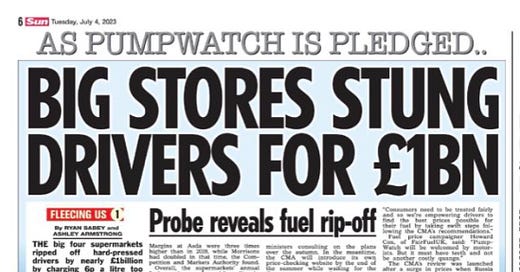This week has seen a further slew of press stories based around the “greedflation” theme which we explored in last week’s post here on Moving Tribes.
In part, that’s been fuelled (pardon the pun) by the UK Competition and Markets Authority writing a long report on the pricing of petrol and diesel for consumers.
The TLDR of the 187 page report is “supermarkets (particularly Asda and Morrisons) have increased their margins on petrol and diesel over the last year, resulting in them charging around 6p more per litre than if they had maintained their lower margins from 2019”.
That’s a pretty awful thing to read in the middle of a cost of living crisis, and has prompted a wave of coverage like this from the Sun:
But …
As is often the case, a closer read reveals some other facts in the CMA report that may be slightly awkward for the angry mob - namely:
The supermarkets who have raised their margins were by far the cheapest retailers of petrol and diesel and by and large still are
All the CMA analysis supports the argument that petrol prices are locally set and more or less determined by the intensity of competition in an area (so motorway services stations = high price, tonnes of local supermarkets = low price)
There have been one or two global events since 2019 (!) which have had a big impact on the margin pressures and competitive intensity supermarkets feel in their main food categories, something the CMA acknowledges but has consciously excluded from its analysis
So the headline
“evil supermarkets are ripping you off”
might just as easily be
“a couple of brands which ran with incredibly thin margins on petrol to try to entice you into buying your groceries from them have decided they can no longer afford to do so”
which won’t fit on a Sun Business page but certainly paints a different picture.
Now to be fair to the CMA, their job is to ensure markets are as competitive as possible, and there are plenty of ways they could recommend to the rest of government to achieve that in petrol retailing. Given that the overwhelming driver of pricing in petrol is proximity to other petrol stations, the most obvious way of doing that would be to change planning regulations and open more of them. Some of the other remedies in the CMA report (like ensuring better visibility of local prices) might also help too at the margin.
But what really stands out to me both from the report but especially from some of the debate it has caused is the instinctive and angry “something must be done” response of reaching for price controls. Supermarkets shouldn’t, the narrative goes, be allowed to charge these “big” margins and so a regulator should intervene and force prices down.
That’s a policy remedy which makes sense, as long as you don’t think too much about the consequences of implementing it. Indeed, it is only a few weeks since politicians were openly talking about the same kind of policy weapon, also aimed at supermarkets, on food pricing.
So what could go wrong with getting a government department to tell Asda what to charge for petrol? Well, consider:
there is a return on investment that any commercial organisation needs to achieve, and so squeezing petrol prices too low much result in a reduction in promotional intensity in other areas - are you really willing to pay more for milk in order to pay less for petrol?
In the end, holding returns in a market down below those which the market generates must result in reduced investment in the market. Taken to its logical extreme, if the supermarkets just decided to stop selling petrol, then the whole market would become less competitive, exactly the opposite of the outcome sought.
To be clear, there are remedies for government if it thinks the petrol market is not competitive enough - take actions to increase competitive intensity. But reaching for the panacea of simply deciding what prices should be is a dangerous course of action and has too often in the past ended up creating the opposite of the outcome being sought.
P.S.
Remember Tom and Joanna, our hypothetical high-worth couple who turned out not to be as high-worth as we thought once we considered the potential impact of interest rate rises? I was reminded of them this morning reading a retail analysis from the excellent folks at RBC Capital Markets which included this fascinating chart:
Note that the number of people feeling either slightly or much worse about their spending power has not changed all that much between Jan 23 and Jun 23, but within that total the proportion feeling ‘much worse’ has increase significantly.
The overall consumer narrative that since Covid the population has really split into those with savings still to spend and those who have not is really starkly illustrated here in this chart, and can only get worse as interest rate rises really bite. A challenging time ahead for any consumer business to navigate, I suspect.






Coming late to this post, which I agree with, but have two additional points:
1. It is hard to encourage greater investment in petrol stations, given the move to electric vehicles that will see demand for petrol/diesel steadily fall. There aren't many years now in which construction costs can be paid back. So firms leaving the market is probably undesirable (except in response to electrification of the sector, which can't come soon enough).
2. I suspect it's not just about who has savings left; owner occupiers and those still on a low fixed-rate mortgage will be much better placed to cope with inflationary pressures than others.